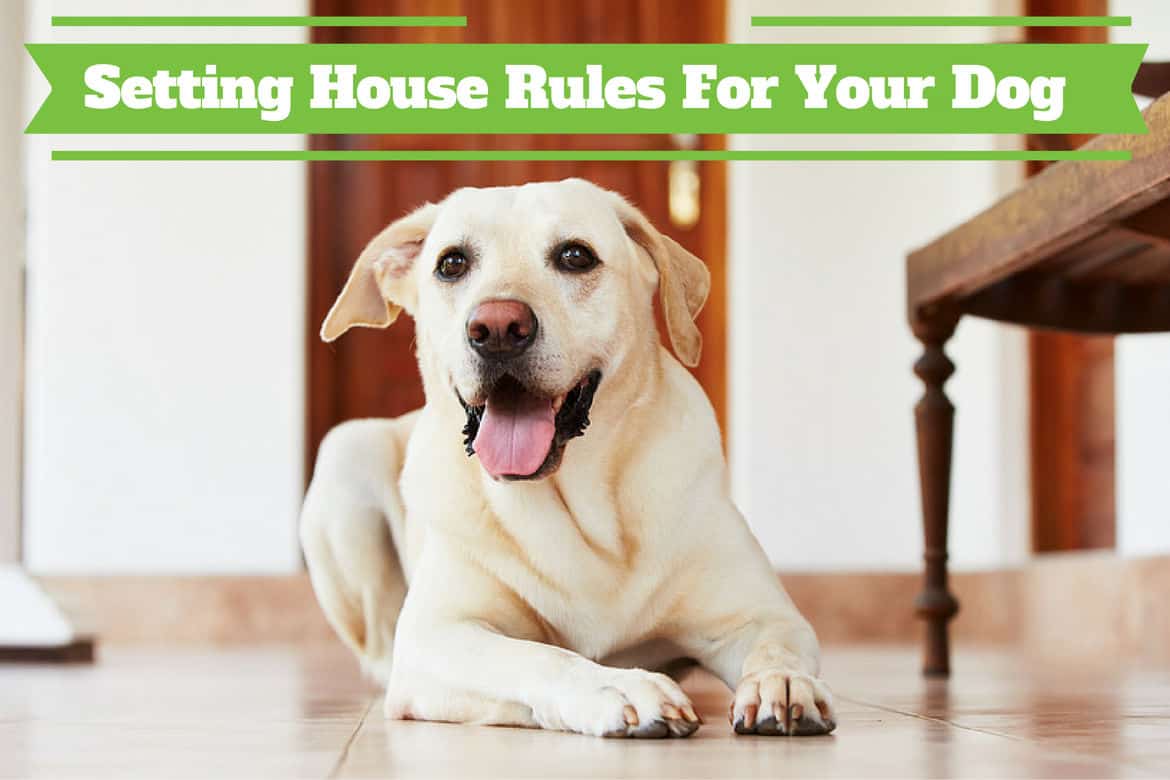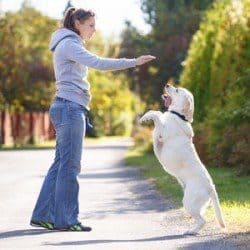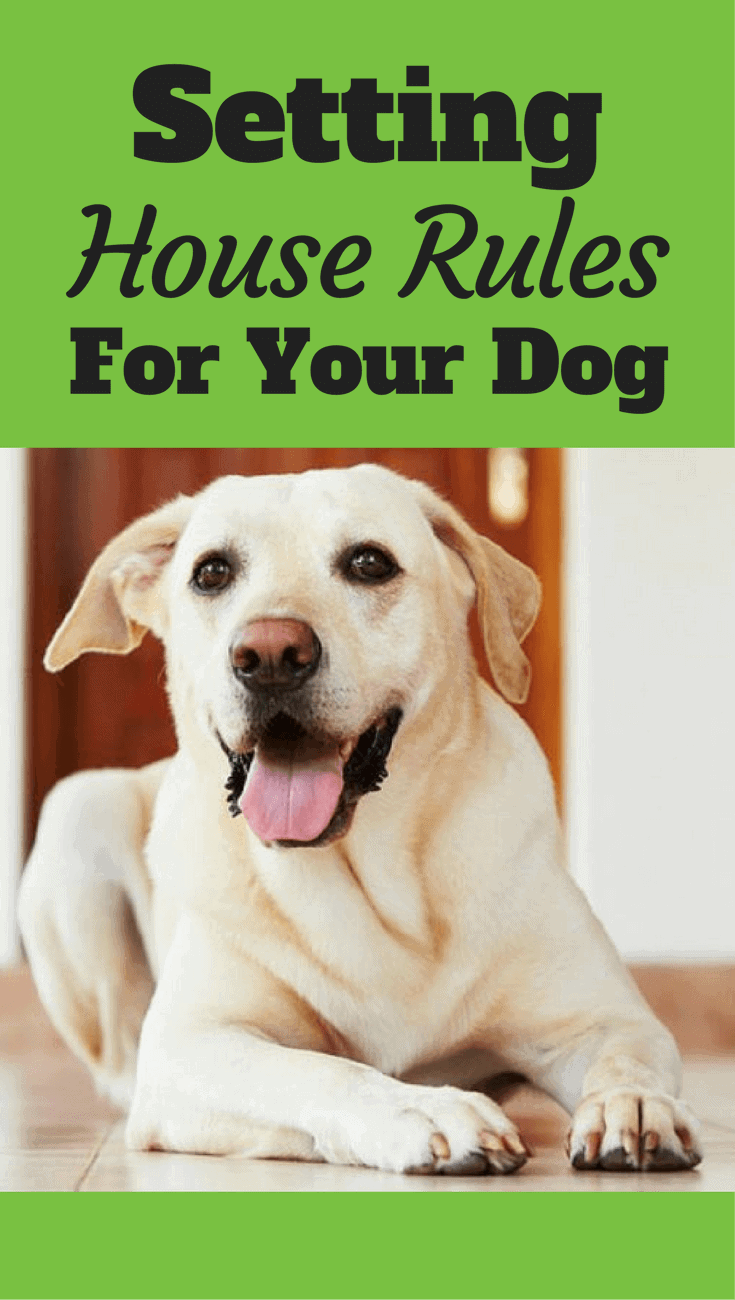This post may contain affiliate links. We may earn money or products from the companies mentioned in this post.

Before bringing a Labrador into your life and home, it’s extremely important to sit down with the members of your household and agree a set of rules that everyone has to live by.
By this I mean a set of rules not just for the dog, but the children, the adults, every human in the household too!
Every home and every family is different so it’s up to you, your Labs family, to decide what behavior is and isn’t acceptable.
But making up a few rules isn’t the end of the story.
It’s vitally important that everybody in the home applies them consistently at all times so your dog knows exactly what you expect of them and what they can expect of you.
Why Setting House Rules For Dogs Is So Important
Remember, dogs aren’t human.
They have to learn how to live in this strange human world where many of their natural behaviors aren’t agreeable to us.
Many things they’d do if left to their own devices could be dangerous, destructive, unhygienic or simply something we’d rather they didn’t do.
By drawing up a set of house rules for your Lab, you’re letting them know what is and is not acceptable in your home.
Otherwise, how are they to know? They’ll just do whatever comes naturally.
To help them grow into a well-behaved and well-mannered family member, trusted to know how to act accordingly at all times, you need to teach them a set of rules to live by. And this is the responsibility of everybody in the home.
This then creates an environment where they do less wrong, get corrected less often and praised and loved more. And this means less stress for everybody involved. Relationships grow stronger and the entire household, humans and dog will be far happier.
Consistently Sticking To The House Rules Is Key!
It’s OK to set a few house rules, but unless every single person sticks to them 100% of the time, your Lab will get confused and not know how they’re supposed to act.
As an example it’s hard to tell your Lab they’re not allowed upstairs if when you’re not there your children are sitting on their beds with them, feeding them crisps and sweets!
If they can get away with something once, or one person lets them do something, they will chance their arm or find it hard to accept being told ‘no!’ the next time or by someone else.
It also takes far less time and training to teach a dog that they 100% can do something, or 100% can’t, rather than they can do something sometimes and not others.
So the most important thing to teaching house rules to your dog is once you’ve made the decision, everybody has to stick to it. 100% of the time. No exceptions.
This is the only fair and dare I say it, the only way you’ll be able to teach your Lab to accept and live by some rules.
Although Consistency Is Key, There Can Be A Middle Ground
Going somewhat against the last point, there can be a middle ground instead of hard and fast rules, but I recommend a certain way of doing things.
As an example, most people don’t want their dogs up on the furniture only most of the time, so you should first teach your Lab they are ‘never’ allowed on the furniture. Once they truly understand this, proving it for many months, you can then train them a command, ‘SOFA!’ or something similar, for when they are allowed to come onto the sofa and cuddle.
This works well because they’ve been taught they must never go on the furniture…ever! And for months have proved they understand and accept this.
By then going from this background to a single command that does allow them, the dog will learn it’s never OK unless they hear that one command.
This will be far more successful than allowing a dog onto the comfort of a sofa sometimes and trying to shift a stubborn dog off if they currently aren’t welcome. It will also be far less confusing and your dog will be far more accepting of it: “I’m not allowed up ever, except for the occasional time as a treat!”
So always try to set ‘black and white’, ‘always or never’ rules, wait months until you know the rule has been truly learned and accepted, and then you can teach commands for a middle ground for those occasional exceptional circumstances.
I use this strategy myself for many rules with great success ;-)
What House Rules Need To Be Decided?
There need to be rules for your Lab so they learn what’s OK and what’s not, where they may go and where they may not, the things they can do and the things they must not.
But equally there’s a need for a definite set of rules for the humans in the house, especially any children. House-members need to know what the dog can do and what it may not, what they can do with the dog and what they may not, and who must perform daily care tasks for the dog and at what times.
Following is a list of the most common things you’ll want to decide upon before bringing your Labrador home. Rules not just for your Lab, but for the humans they live with also:
Where In The House Is The Dog Allowed?
Many people would rather their dogs didn’t go into certain areas of their home: The kitchen, the baby’s play room or a dining room where entertaining takes place.
Others restrict their dogs to ground level only and do not allow them upstairs.
If a rule like this is made, you want to use baby gates to restrict your Labs access and make sure nobody ever lets them into these areas. If your Lab has free run of the house at some times it will be very hard to restrict them at others.
Personally I always restrict a puppy and gradually open up the house as they grow and learn, finally allowing my dogs to have free roam of the house and restrict them only at certain times if a need arises.
To get the love and attention my dogs deserve, and for me to get it from them, they need enough access to the home to be where me and my family are :-)
Should You Let Your Dog Up On The Furniture?
There are a few things to consider when deciding whether or not your Labrador is allowed on the furniture:
- They are a big breed and take up a fair bit of space. Basically, at least a seat to themselves.
- They shed a lot of hair so if they’re allowed up on your sofa and chairs, expect them to gain a new covering that will transfer onto everyone’s clothing, and that you’ll have to invest in a decent pet hair vacuum.
- Labs love water, rolling in mud…and other smelly things too if they get the chance. So there’s a high probability that not only will your furniture get wet and dirty, but you’ll occasionally find something you’d really rather wasn’t there.

You may find it cute to have your Labrador puppy snuggling up with you on the sofa, but if you allow this it will be extremely hard to change the rule once they become a 75 pound adult and you’d rather they weren’t on your lap!
So your options are to either never let them on the furniture, always let them on the furniture, or try to train them an option in between.
Instead of completely banning them from furniture, you can decide to let them on a single chair only. Or spend the time to train them they must not come up unless invited with a cue word. I prefer this middle balance myself.
Should You Feed Your Dog Table Scraps Or Treats From The Dinner Table?
I always make sure people know to never feed my dogs anything from the table or their dinner plates.
Dogs only need to think they’ll get a treat sometimes, even just once in a blue moon and they learn to stare and beg constantly. Even if you don’t mind this yourself, many of your visitors might.
So you need to decide from the start whether you’re OK with this and make sure everybody follows the rule.
When I do give Monty any table scraps or treats, I always take them to his food bowl and never feed him from the table.
Rules For Going Through Doors And Gates
All dogs should be taught to wait until given permission to go through doors and gates. And this can be a true life saver!
Many dogs end up injured or worse when hit by cars after running away through open doors and gates.
So train your dog not to go through a door until you say so. And this will have to be consistently trained, every time and by all members of the household for it to be truly effective.
You want them to stay inside whether people are coming or going, or if the door is left open unattended. You may not feel much benefit if you do this, but you may one day feel incredible regret if you don’t.
Another benefit of your Lab waiting for permission to go through doors and gates is they will not charge and bustle through with you, getting under your feet and tripping you up. I see so many dogs do this all the time!
Dangerous…and a little frustrating if I do say so myself.
Who Will Take Responsibility For Certain Care Tasks
You want to decide long before getting a dog exactly who will take care of all the tasks required to look after them properly. What needs to be done, by whom, when and how often.
Things you need to consider are:
- Who will exercise the dog and when?
- Who is responsible for feeding your new friend?
- Who will brush your Labrador, trim their nails and inspect them all over for good health? When and how often?
- Who will undertake training sessions and when?
- Who will clean up the toilet area in your back yard?
Properly caring for your Lab requires time and dedication. You cannot skip tasks for fear of neglecting your pet.
So to avoid things being forgotten, and to avoid potential arguments of who hasn’t done what, you want to agree and draw up a rota of who is responsible for what.
And I encourage everybody in the home, that’s adults and children to get involved. Particularly with grooming and training as it builds bonds and a stronger relationship between each family member and your dog.
When Giving Commands, Which Words And Accompanying Hand Signals Will You Use As Cues?
Your Labrador has so much to learn in a difficult second language, so you should strive to make it as easy as you possibly can for them.

The way you do this is to limit the number of words and gestures they have to learn and make sure everybody teaches and uses the same ones.
So before you get your new dog home, make sure you assign cue words and signals for things like sit, come, down, stay, etc. and make sure that every person in the home knows and uses them.
This will limit how many words and signals your dog has to learn, will avoid confusion and will ultimately end with quicker learning and you having better control of your dog when needed.
Will You Allow Your Dog To Jump Up When Greeting People?
It’s fun and exciting to be greeted by a boisterous dog going absolutely crazy because they’re just so pleased to see you. Jumping up, licking your face, their tail wagging at 300 beats a minute.
But I strongly recommend that a dog as large as a Labrador be taught not to jump up.
They can easily bowl over strong adults, let alone small children and the elderly. And let’s not forget those muddy paw prints and ripped tights that only ever seem to happen when you’re dressed up and about to go out.
To stop your Lab jumping up you have to teach them that it’s never OK. You can’t allow it sometimes and not at others. A Lab can’t tell the difference between a tracksuit and an Armani suit, they will just think jumping up is OK. And if you let them do it once, you can’t tell them off another time as that would just be unfair.
Of course there’s always a middle ground, but it takes more time and dedication to teach. If you still want those welcoming hugs there is the option of teaching to hug on command. But it’d be best to teach them not to jump up at all for many months first to avoid confusion.
Rules Specifically For Humans: Basic Manners And Respect Towards Your Dog
People need to understand your dog is a valued family member that deserves to be well treated, respected and should have a few rights of their own around the home.
It’s particularly important you’re clear about such rules with children who can sometimes see pets as their play things, to toy with and to pick up and put down whenever they wish.
Some of the things you may want to make clear are:
- Developing Puppies need a lot of sleep. So when they’re sleeping in their crate or bed, people shouldn’t disturb them.
- Do not disturb the puppy or dog when eating. This can cause anxiety and lead to resource guarding and aggression.
- Your dogs crate is a place for them and them only. A place they can go to get away things and know they will be safe, secure and left alone for peace and quiet. It’s not a child’s play pen, no children should be allowed inside and they shouldn’t be allowed to bother your Lab when in there.
- Never tease your puppy or dog, especially with food or toys as this can lead to frustration, possessiveness and sometimes aggression.
- Never yell at or hit the dog. It achieves nothing, they do not understand and only serves to make them less trusting and unsure around people.
- Children need to be told and shown how to handle a puppy with care and respect. No ear pulling, tail pulling, pinching or prodding. Hold the puppy when sitting down only, no picking them up in case they’re dropped. And if the puppy wants releasing, they must let them go immediately.
These are just a few guidelines on how we must act around our dogs. I’m sure you can think of more, but this is a good place to start.
Miscellaneous / Other Rules To Consider
This article’s getting a bit long now (sorry!) so I’ll list just a few other short things you may want to consider before wrapping things up:
- Where should the puppy sleep? If the children let it up and into their beds, it will be extremely hard to break the habit later. So can they sleep in the bedrooms or not? Decide and stick to it! No smuggling puppies into bedrooms if it’s not allowed for if they get used to it, crying at night will be the result if you deny them the privilege.
- Where will the puppy’s toilet area be? Pick a spot outside, make sure everyone knows where it is, ensure children do not play there and everybody takes puppy to toilet in this same place.
- Never leave things lying around on the floor. Discuss puppy-proofing the home and how everybody needs to keep it that way. Shoes? Pencil case? Mobile phone? They will get chewed, it could be expensive and might risk your puppy’s health!
- You all need to work towards the rule of ‘No teeth on skin, ever!’ There should always be a toy between a child’s hand and a puppy’s teeth. Teach your children the fundamentals of how to train bite-inhibition and do not allow the puppy to bite.
- If a multi-pet household, lay down rules for how the pets should interact. No chasing, eating other pets food, or taking over their sleeping area for instance. And never leave two pets alone until you’re absolutely sure they can be trusted not to fight. Everybody needs to enforce this, perhaps by always removing one of the pets when you leave the room.
When You’re Ready To Collect Your Puppy
When the time finally arrives, be sure to check out our article on bringing home your new puppy!
It’s chock full of tips and advice for making the experience go as smoothly as possible and will make yours and your puppy’s transition into your new lives together as stress free as can be.
It’s definitely recommended reading!
Final Thoughts On Setting House Rules For Dogs…And Their Family
I’ve covered the main rules and things you should decide before you bring your Labrador home. But as previously stated, every home and family is different so there isn’t a single rule-set that will apply to all.
Just think about the belongings and places in your home and how you may or may not want to share them with your dog.
Also how the people in your home and your dog will interact daily and set clear rules about every interaction you can think of.
Remember, what you find cute in a puppy now might not be so cute when the puppy is a fully grown Lab, with adult teeth, a strong will and habits you allowed to form. So think of the future too!
When you decide the rules, write them down and pin them somewhere everybody can see them. Every person in the home must take responsibility to adhere to the rules and remind and correct others too when necessary.
And remember, dogs thrive best when they know what’s expected of them and have been taught what they can and cannot do. Black and white, yes or no. It’s easier to teach and easier to understand.
But once you’ve trained them a rule that they can or cannot do something, and they’ve proven for months they ‘get it’, you can then train a command as an occasional exception and this works very well.
Good luck…I know you’ll do just fine :-)
Save to Pinterest

Top Picks For Our Dogs
- BEST PUPPY TOY
We Like: Calmeroos Puppy Toy w/ Heartbeat and Heat Packs - Perfect for new puppies. Helps ease anxiety in their new home. - BEST DOG CHEW
We Like: Bones & Chews Bully Sticks - All of our puppies love to bite, nip, and chew. We love using Bully Sticks to help divert these unwanted behaviors. - BEST DOG TREATS
We Like: Crazy Dog Train Me Treats - One of our favorite treats for training our service dog puppies. - BEST FRESH DOG FOOD
We Like: The Farmer's Dog - A couple months ago we started feeding Raven fresh dog food and she loves it! Get 50% off your first order of The Farmer's Dog.
For a list of all the supplies we get for our new service dog puppies check out our New Puppy Checklist on the PuppyInTraining.com blog.
2 comments
Can I allow my lab to sleep in the balcony? Will he be affected by mosquito bites?
Hi Radhika,
Any ‘outside dog’ should have ample shelter from the elements, not simply made to sleep on a balcony where they are very exposed.